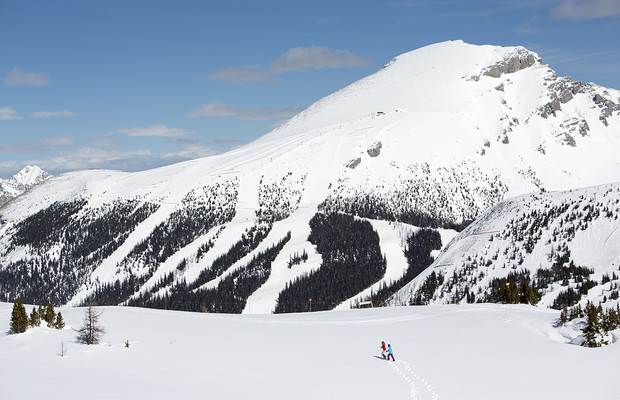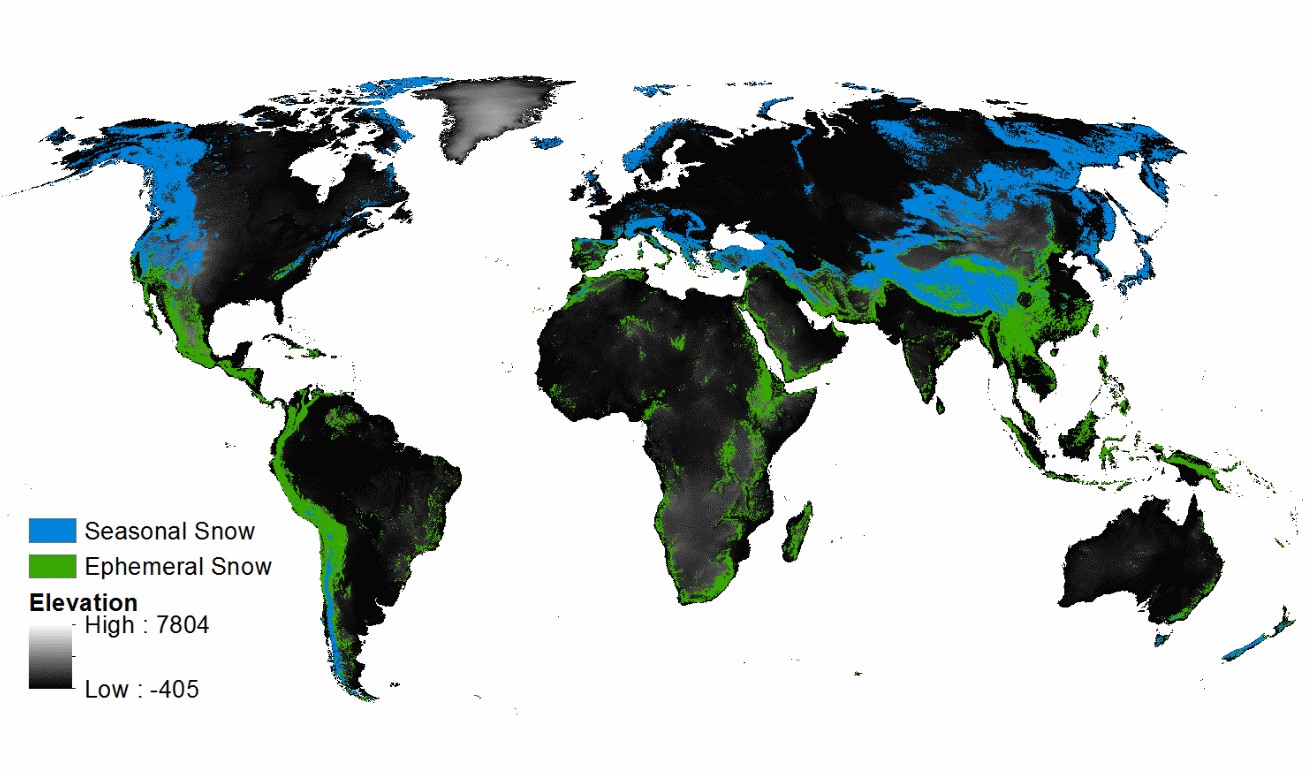How Much Snow Accumulates in North America Each Year? More than Scientists Thought
Special Stories
30 Mar 2018 3:16 PM
From Ohio State University
There’s a lot more snow piling up in the mountains of North America than anyone knew, according to a first-of-its-kind study.
Scientists have revised an estimate of snow volume for the entire continent, and they’ve discovered that snow accumulation in a typical year is 50 percent higher than previously thought.
In the journal Geophysical Research Letters, researchers at The Ohio State University place the yearly estimate at about 1,200 cubic miles of snow accumulation. If spread evenly across the surface of the continent from Canada to Mexico, the snow would measure a little over 7.5 inches deep. If confined to Ohio, it would bury the state under 150 feet of snow.
Most of the snow accumulates atop the Canadian Rockies and 10 other mountain ranges. And while these mountains compose only a quarter of the continent’s land area, they hold 60 percent of the snow, the researchers determined.
 [Researchers at the Ohio State University and their colleagues are working to get more precise estimates of snow accumulation on North America. The majority of snow accumulates in the Canadian Rockies, they found. Image courtesy of Banff & Lake Louise Tourism / Paul Zizka Photography.]
The research represents an important step toward understanding the true extent of fresh water sources on the continent, explained doctoral student Melissa Wrzesien, lead author on the paper.
“Our big result was that there’s a lot more snow in the mountains than we previously thought,” she said. “That suggests that mountain snow plays a much larger role in the continental water budget than we knew.”
It’s currently impossible to directly measure how much water is on the planet, said Michael Durand, associate professor of earth sciences at Ohio State. “It’s extremely important to know—not just so we can make estimates of available fresh water, but also because we don’t fully understand Earth’s water cycle.”
The fundamentals are known, Durand explained. Water evaporates, condenses over mountains and falls to earth as rain or snow. From there, snow melts, and water runs into rivers and lakes and ultimately into the ocean.
[Researchers at the Ohio State University and their colleagues are working to get more precise estimates of snow accumulation on North America. The majority of snow accumulates in the Canadian Rockies, they found. Image courtesy of Banff & Lake Louise Tourism / Paul Zizka Photography.]
The research represents an important step toward understanding the true extent of fresh water sources on the continent, explained doctoral student Melissa Wrzesien, lead author on the paper.
“Our big result was that there’s a lot more snow in the mountains than we previously thought,” she said. “That suggests that mountain snow plays a much larger role in the continental water budget than we knew.”
It’s currently impossible to directly measure how much water is on the planet, said Michael Durand, associate professor of earth sciences at Ohio State. “It’s extremely important to know—not just so we can make estimates of available fresh water, but also because we don’t fully understand Earth’s water cycle.”
The fundamentals are known, Durand explained. Water evaporates, condenses over mountains and falls to earth as rain or snow. From there, snow melts, and water runs into rivers and lakes and ultimately into the ocean.
 [Global elevation map with green areas representing mountainous regions without seasonal snowpack and blue areas representing mountainous regions with a seasonal snowpack.]
But exactly how much water there is—or what proportion of it falls as snow or rain—isn’t precisely known. Satellites make reasonable measurements of snow on the plains where the ground is flat, though uncertainties persist even there. But mountain terrain is too unpredictable for current satellites. That’s why researchers have to construct regional climate computer models to get a handle on snow accumulation at the continental scale.
For her doctoral thesis, Wrzesien is combining different regional climate models to make a more precise estimate of annual snow accumulation on 11 North American mountain ranges, including the Canadian Rockies, the Cascades, the Sierra Nevada and the Appalachian Mountains. She stitches those results together with snow accumulation data from the plains.
[Global elevation map with green areas representing mountainous regions without seasonal snowpack and blue areas representing mountainous regions with a seasonal snowpack.]
But exactly how much water there is—or what proportion of it falls as snow or rain—isn’t precisely known. Satellites make reasonable measurements of snow on the plains where the ground is flat, though uncertainties persist even there. But mountain terrain is too unpredictable for current satellites. That’s why researchers have to construct regional climate computer models to get a handle on snow accumulation at the continental scale.
For her doctoral thesis, Wrzesien is combining different regional climate models to make a more precise estimate of annual snow accumulation on 11 North American mountain ranges, including the Canadian Rockies, the Cascades, the Sierra Nevada and the Appalachian Mountains. She stitches those results together with snow accumulation data from the plains.
 [Melissa Wrzesien, Graduate Student, Ohio State University]
So far, the project has consumed 1.8 million core-hours on NASA’s Pleiades supercomputer and produced about 16 terabytes of data. On a typical laptop, the calculations would have taken about 50 years to complete.
Whereas scientists previously thought the continent held a little more than 750 cubic miles of snow each year, the Ohio State researchers found the total to be closer to 1,200 cubic miles.
They actually measure snow-water equivalent, the amount of water that would form if the snow melted—at about a 3-to-1 ratio. For North America, the snow-water equivalent would be around 400 cubic miles of water—enough to flood the entire continent 2.5 inches deep, or the state of Ohio 50 feet deep.
[Melissa Wrzesien, Graduate Student, Ohio State University]
So far, the project has consumed 1.8 million core-hours on NASA’s Pleiades supercomputer and produced about 16 terabytes of data. On a typical laptop, the calculations would have taken about 50 years to complete.
Whereas scientists previously thought the continent held a little more than 750 cubic miles of snow each year, the Ohio State researchers found the total to be closer to 1,200 cubic miles.
They actually measure snow-water equivalent, the amount of water that would form if the snow melted—at about a 3-to-1 ratio. For North America, the snow-water equivalent would be around 400 cubic miles of water—enough to flood the entire continent 2.5 inches deep, or the state of Ohio 50 feet deep.
 [Michael Durand, Associate Professor of Earth Sciences at Ohio State]
And while previous estimates placed one-third of North American snow accumulation in the mountains and two-thirds on the plains, the exact opposite turned out to be true: Around 60 percent of North American snow accumulation happens in the mountains, with the Canadian Rockies holding as much snow as the other 10 mountain ranges in the study combined.
“Each of these ranges is a huge part of the climate system,” Durand said, “but I don’t think we realized how important the Canadian Rockies really are. We hope that by drawing attention to the importance of the mountains, this work will help spur development in understanding how mountains fit into the large-scale picture.”
What scientists really need, he said, is a dedicated satellite capable of measuring snow depth in both complex terrain and in the plains. He and his colleagues are part of a collaboration that is proposing just such a satellite.
Edited for WeatherNation by Meteorologist Mace Michaels
[Michael Durand, Associate Professor of Earth Sciences at Ohio State]
And while previous estimates placed one-third of North American snow accumulation in the mountains and two-thirds on the plains, the exact opposite turned out to be true: Around 60 percent of North American snow accumulation happens in the mountains, with the Canadian Rockies holding as much snow as the other 10 mountain ranges in the study combined.
“Each of these ranges is a huge part of the climate system,” Durand said, “but I don’t think we realized how important the Canadian Rockies really are. We hope that by drawing attention to the importance of the mountains, this work will help spur development in understanding how mountains fit into the large-scale picture.”
What scientists really need, he said, is a dedicated satellite capable of measuring snow depth in both complex terrain and in the plains. He and his colleagues are part of a collaboration that is proposing just such a satellite.
Edited for WeatherNation by Meteorologist Mace Michaels
 [Researchers at the Ohio State University and their colleagues are working to get more precise estimates of snow accumulation on North America. The majority of snow accumulates in the Canadian Rockies, they found. Image courtesy of Banff & Lake Louise Tourism / Paul Zizka Photography.]
The research represents an important step toward understanding the true extent of fresh water sources on the continent, explained doctoral student Melissa Wrzesien, lead author on the paper.
“Our big result was that there’s a lot more snow in the mountains than we previously thought,” she said. “That suggests that mountain snow plays a much larger role in the continental water budget than we knew.”
It’s currently impossible to directly measure how much water is on the planet, said Michael Durand, associate professor of earth sciences at Ohio State. “It’s extremely important to know—not just so we can make estimates of available fresh water, but also because we don’t fully understand Earth’s water cycle.”
The fundamentals are known, Durand explained. Water evaporates, condenses over mountains and falls to earth as rain or snow. From there, snow melts, and water runs into rivers and lakes and ultimately into the ocean.
[Researchers at the Ohio State University and their colleagues are working to get more precise estimates of snow accumulation on North America. The majority of snow accumulates in the Canadian Rockies, they found. Image courtesy of Banff & Lake Louise Tourism / Paul Zizka Photography.]
The research represents an important step toward understanding the true extent of fresh water sources on the continent, explained doctoral student Melissa Wrzesien, lead author on the paper.
“Our big result was that there’s a lot more snow in the mountains than we previously thought,” she said. “That suggests that mountain snow plays a much larger role in the continental water budget than we knew.”
It’s currently impossible to directly measure how much water is on the planet, said Michael Durand, associate professor of earth sciences at Ohio State. “It’s extremely important to know—not just so we can make estimates of available fresh water, but also because we don’t fully understand Earth’s water cycle.”
The fundamentals are known, Durand explained. Water evaporates, condenses over mountains and falls to earth as rain or snow. From there, snow melts, and water runs into rivers and lakes and ultimately into the ocean.
 [Global elevation map with green areas representing mountainous regions without seasonal snowpack and blue areas representing mountainous regions with a seasonal snowpack.]
But exactly how much water there is—or what proportion of it falls as snow or rain—isn’t precisely known. Satellites make reasonable measurements of snow on the plains where the ground is flat, though uncertainties persist even there. But mountain terrain is too unpredictable for current satellites. That’s why researchers have to construct regional climate computer models to get a handle on snow accumulation at the continental scale.
For her doctoral thesis, Wrzesien is combining different regional climate models to make a more precise estimate of annual snow accumulation on 11 North American mountain ranges, including the Canadian Rockies, the Cascades, the Sierra Nevada and the Appalachian Mountains. She stitches those results together with snow accumulation data from the plains.
[Global elevation map with green areas representing mountainous regions without seasonal snowpack and blue areas representing mountainous regions with a seasonal snowpack.]
But exactly how much water there is—or what proportion of it falls as snow or rain—isn’t precisely known. Satellites make reasonable measurements of snow on the plains where the ground is flat, though uncertainties persist even there. But mountain terrain is too unpredictable for current satellites. That’s why researchers have to construct regional climate computer models to get a handle on snow accumulation at the continental scale.
For her doctoral thesis, Wrzesien is combining different regional climate models to make a more precise estimate of annual snow accumulation on 11 North American mountain ranges, including the Canadian Rockies, the Cascades, the Sierra Nevada and the Appalachian Mountains. She stitches those results together with snow accumulation data from the plains.
 [Melissa Wrzesien, Graduate Student, Ohio State University]
So far, the project has consumed 1.8 million core-hours on NASA’s Pleiades supercomputer and produced about 16 terabytes of data. On a typical laptop, the calculations would have taken about 50 years to complete.
Whereas scientists previously thought the continent held a little more than 750 cubic miles of snow each year, the Ohio State researchers found the total to be closer to 1,200 cubic miles.
They actually measure snow-water equivalent, the amount of water that would form if the snow melted—at about a 3-to-1 ratio. For North America, the snow-water equivalent would be around 400 cubic miles of water—enough to flood the entire continent 2.5 inches deep, or the state of Ohio 50 feet deep.
[Melissa Wrzesien, Graduate Student, Ohio State University]
So far, the project has consumed 1.8 million core-hours on NASA’s Pleiades supercomputer and produced about 16 terabytes of data. On a typical laptop, the calculations would have taken about 50 years to complete.
Whereas scientists previously thought the continent held a little more than 750 cubic miles of snow each year, the Ohio State researchers found the total to be closer to 1,200 cubic miles.
They actually measure snow-water equivalent, the amount of water that would form if the snow melted—at about a 3-to-1 ratio. For North America, the snow-water equivalent would be around 400 cubic miles of water—enough to flood the entire continent 2.5 inches deep, or the state of Ohio 50 feet deep.
 [Michael Durand, Associate Professor of Earth Sciences at Ohio State]
And while previous estimates placed one-third of North American snow accumulation in the mountains and two-thirds on the plains, the exact opposite turned out to be true: Around 60 percent of North American snow accumulation happens in the mountains, with the Canadian Rockies holding as much snow as the other 10 mountain ranges in the study combined.
“Each of these ranges is a huge part of the climate system,” Durand said, “but I don’t think we realized how important the Canadian Rockies really are. We hope that by drawing attention to the importance of the mountains, this work will help spur development in understanding how mountains fit into the large-scale picture.”
What scientists really need, he said, is a dedicated satellite capable of measuring snow depth in both complex terrain and in the plains. He and his colleagues are part of a collaboration that is proposing just such a satellite.
Edited for WeatherNation by Meteorologist Mace Michaels
[Michael Durand, Associate Professor of Earth Sciences at Ohio State]
And while previous estimates placed one-third of North American snow accumulation in the mountains and two-thirds on the plains, the exact opposite turned out to be true: Around 60 percent of North American snow accumulation happens in the mountains, with the Canadian Rockies holding as much snow as the other 10 mountain ranges in the study combined.
“Each of these ranges is a huge part of the climate system,” Durand said, “but I don’t think we realized how important the Canadian Rockies really are. We hope that by drawing attention to the importance of the mountains, this work will help spur development in understanding how mountains fit into the large-scale picture.”
What scientists really need, he said, is a dedicated satellite capable of measuring snow depth in both complex terrain and in the plains. He and his colleagues are part of a collaboration that is proposing just such a satellite.
Edited for WeatherNation by Meteorologist Mace MichaelsAll Weather News
More